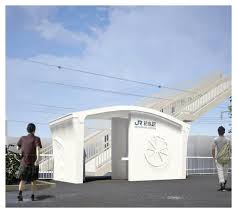World’s First 3D-Printed Train Station unveiled in Japan

- 10 Apr 2025
In News:
Japan’s West Japan Railway Company has unveiled the world’s first 3D-printed train station — Hatsushima Station in Arida city. Notably, the station was constructed in less than six hours, highlighting a major advancement in construction technology.
Understanding 3D Printing (Additive Manufacturing)
What is 3D Printing?
3D Printing, or Additive Manufacturing, is a process of creating three-dimensional objects by layering material based on a digital design. Unlike traditional (subtractive) manufacturing, which removes material, this method adds material layer by layer, ensuring reduced waste and the ability to produce complex geometries.
How 3D Printing Works:
- Design Phase: A 3D digital model is created using CAD (Computer-Aided Design) software and saved in formats like .STL or .OBJ.
- Slicing: The model is sliced into horizontal layers using specialized software.
- Printing: The printer deposits material layer-by-layer according to the sliced file. Each layer solidifies to form the final shape.
- Post-Processing: The object is finished through processes such as curing, sanding, or painting.
Major 3D Printing Technologies:
- Fused Deposition Modelling (FDM): Uses melted thermoplastic filaments to build objects layer-by-layer.
- Selective Laser Sintering (SLS): Uses lasers to fuse powdered plastics or metals into solid forms.
- Direct Metal Laser Sintering (DMLS): Employs a laser to fuse metal powders — widely used in aerospace and medical sectors.
- Material Jetting: Deposits photopolymer droplets, cured with UV light — ideal for high-precision and colorful prototypes.
Limitations of 3D Printing:
- Material Restrictions: Only specific plastics, metals, and composites are compatible with given printers.
- Size Constraints: Limited build volume necessitates assembling larger items from smaller parts.
- Structural Weakness: Objects may have weak joints due to the layered structure, reducing suitability for high-stress uses.
- IP Challenges: Digital design files can be easily shared, posing risks of counterfeiting and intellectual property theft.
